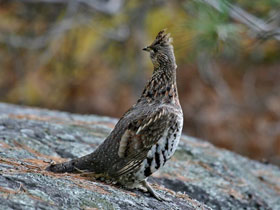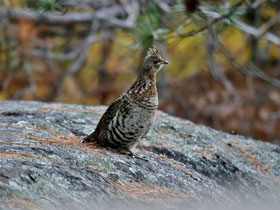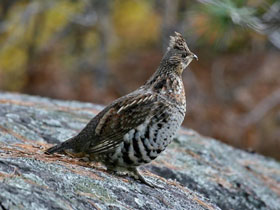The ruffed grouse Bonasa umbellus
This species is presented in two colour morphs: a grey morph and a red morph. These two morphs differ in colour of the dorsal parts of the body, particularly the tail. There are all sorts of intergrades between the two morphs. The coloration of the ruffed grouse is a pattern of rounded patches and drop-shaped streaks of grey, brown, buff and black colour. The body underparts are yellowish grey. The bill is thick, dark brown; the legs are yellowish grey. Both sexes have the ruffs on the sides of the neck. Ruffed grouses have a short, ragged crest on top of the head, and a square tail with a broad, black band at the tip. Males and females have similar colour patterns and sizes, which makes it difficult to tell them apart. However, it becomes possible to define the sex of the bird by the age of 8 to 14 weeks: in the males, the colour of the ring around the eye is reddish-orange, while in the females, the colour of the face is uniform. The body length of the ruffed grouse is 43–48 cm, the tail measures 11.4–19 cm in length, the span of the wings is about 60 cm, the weight varies from 500 to 650 g and may reach 800 g in some adult males.
The ruffed grouse is found in North America, from the Appalachian Mountains across Canada to central Alaska. These birds inhabit diverse habitats including coniferous and broadleaf forests, open areas (roads, grasslands, cultivated fields), and the regions around tundra and prairie zones. They are also seen in the mountain forests and scrublands. They sometimes occur at elevations of up to 1,600 meters above sea level.
Ruffed grouses are omnivores, but they feed predominantly on plant foods (buds, sprouts, leaves, acorns, wattles, fruit, seeds, berries, nuts, and coniferous needles), which comprise 93–97 % of their diet, though they also consume ants, grasshoppers, worms, snails, and spiders, especially in the breeding season. Insects and invertebrates present almost 90% of the chicks’ diet. High protein foods comprise 18–22 % of the diet. Ruffed grouses obtain 40–70% of the water from the food they eat.
Ruffed grouses are sedentary, but young birds may move over the distances of more than 2.3 km in early autumn, when broods disperse; these short-distance migrations occur for 2 to 5 weeks. In winter, the females move wider than the males, which difference may be attributed to the territorial behaviours of the males. In late autumn, the ruffed grouse grows firm protrusions, called pectinations, along the outside edge of its toes. The pectinations help the birds to walk on snow and cling to icy branches. In winter, ruffed grouses feed in the morning, gathering in groups of up to ten birds. They fill up their crop with food and return to the roosting tree where they can safely digest their food. In the afternoon, they forage again. When the snow is fluffy and the thickness of snow cover is over 25 high, the birds dive head first into the snow and spend night in their shelter, which allows the grouse to stay warm even in the cold weather. In most inclement conditions, the grouses may spend several days in their snow domes.
Ruffled grouses rarely fly far, preferring to walk or even run away from danger. They fly low over the tops of trees or shrubs. When flushed, the grouse will fly up with loud rattling sounds. Ruffed grouses walk confidently, spreading the tail, holding their head up, and often raising the crest. For a few seconds, they can balance standing on one leg and producing soft clucking sounds. If the bird discovers that it is watched, it will start running with its head down or take in the air.
Adult ruffed grouse males are territorial; the sizes of their breeding territories range from 2.3 to 4.5 ha. Young males occupy home ranges of 1.7-4.2 ha, while the size of the female’s territory depends on the season (it increases in the breeding season). At the beginning of breeding season, the male ruffed grouse establishes a breeding territory and tries to attract a female. The males perform their display on a raised platform, such as a trunk of fallen tree, thick log, or stone. The bird quickly rotates its wings forward and backward. The air that rushes into the temporary vacuum beneath the wings creates a miniature vacuum, generating a deep, thumping sound. As the female approaches, the male struts along the log or stone, with his tail fanned out and the ruff and crest erect. Mating occurs on the male’s territory, and a male may mate with several females during the breeding season.
The female builds a nest in the ground, usually in a hollow depression at the base of a tree, under a cliff, or in a hollow log. The nests are located near a source of water (43% of all nests) or within 100 meters from such a source. The female lines the nest with dry leaves, coniferous needles, and a small amount of her own feathers. Egg-laying starts 2–6 days after mating. The female lays from 4 to 19 (average clutch size is 11.5) whitish or brownish eggs, with egg-laying interval of 25–30 hours. Incubation begins after the female has laid her last egg and lasts for 23–24 days.
The chicks hatch at the same time, and in a few hours, the female takes them to the young oak forest or in the thickets of elder trees. Moulting of chicks starts immediately after hatching, and the next, post-juvenile moulting occurs at the age of 7 weeks. During the following 8–12 weeks, the female walks her brood within her brood-rearing territory measuring 10–40 acres. She distracts predators from her brood, imitating behaviour of an injured bird. The chick mortality rate is very high: 33 to 50% of all chicks die during their first month of life. The female takes care of the chicks until they are able to roost on trees. Males do not participate in parental care. By the end of August or beginning of September, young ruffed grouses look very similar to adult birds. They reach sexual maturity by the end of their first year, and the brood split up by late summer. Young birds move singly or in small groups (consisting of the birds of the same brood or different broods). Young ruffed grouse females usually disperse much farther from their parents’ territories than young males.


















































